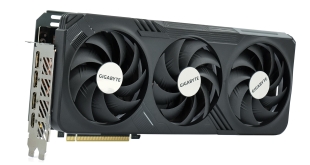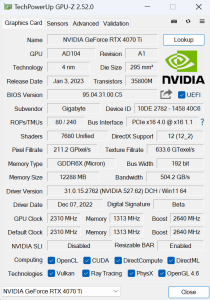
While Nvidia may have officially announced the RTX 4070 Ti at yesterday's CES 2023 keynote, you wouldn't be wrong to think of that as a relaunch, following on from the now infamous RTX 4080 12GB ‘unlaunch'. That's because the RTX 4070 Ti we are reviewing today is the same exact GPU as the RTX 4080 12GB, but with a £150 price cut and, of course, a new name. Hitting the market at £799, what can we expect from this ‘new' graphics card, and is it worth buying? We test gaming performance, overclocking, power draw, thermals and more to find out…
As the third RTX 40-series card to hit the market, the Nvidia RTX 4070 Ti also brings with it a third new Ada Lovelace GPU – AD104. The smallest piece of 40-series silicon yet, RTX 4070 Ti offers 21% fewer CUDA cores than the RTX 4080, with 25% less VRAM, but for a price cut of around 33%. On paper it certainly looks like it will offer better value than its more expensive sibling, but today we will find out whether or not that plays out in practice.
As always, we have plenty of benchmarks and charts to go over, including a detailed look at power draw and efficiency. If you want to read this review as a single page, click HERE.
| RTX 4090 | RTX 4080 | RTX 4070 Ti | RTX 3080 Ti | RTX 3080 | RTX 3070 Ti | |
| Process | TSMC N4 | TSMC N4 | TSMC N4 | Samsung 8N | Samsung 8N | Samsung 8N |
| SMs | 128 | 76 | 60 | 80 | 68 | 48 |
| CUDA Cores | 16384 | 9728 | 7680 | 10240 | 8704 | 6144 |
| Tensor Cores | 512 | 304 | 240 | 320 | 272 | 192 |
| RT Cores | 128 | 76 | 60 | 80 | 68 | 48 |
| Texture Units | 512 | 304 | 240 | 320 | 272 | 192 |
| ROPs | 176 | 112 | 80 | 112 | 96 | 96 |
| GPU Boost Clock | 2520 MHz | 2505 MHz | 2610 MHz | 1665 MHz | 1710 MHz | 1770 MHz |
| Memory Data Rate | 21 Gbps | 22.4 Gbps | 21 Gbps | 19 Gbps | 19 Gbps | 19 Gbps |
| L2 Cache | 73729 KB | 65536 KB | 49152 KB | 6144 KB | 6144 KB | 4096 KB |
| Total Video Memory | 24GB GDDR6X | 16GB GDDR6X | 12GB GDDR6X | 12GB GDDR6X | 10GB GDDR6X | 8GB GDDR6X |
| Memory Interface | 384-bit | 256-bit | 192-bit | 384-bit | 320-bit | 256-bit |
| Memory Bandwidth | 1008 GB/Sec | 716.8 GB/Sec | 504 GB/Sec | 912 GB/Sec | 760 GB/Sec | 608 GB/Sec |
| TGP | 450W | 320W | 285W | 350W | 320W | 290W |
First, for a quick spec recap. We already mentioned that RTX 4070 Ti uses the AD104 die, measuring 295mm2. Accordingly, transistor count is reduced to 35.8 billion, down from 45.9 billion with AD103. The fundamental building blocks are still the same of course, with the RTX 4070 Ti offering a total of 60 Streaming Multiprocessors (SMs), each housing 256 CUDA Cores, for a total of 7680. We also find 60 RT cores, 240 Tensor cores, 240 Texture Units, and 80 ROPs.
TSMC's N4 node has Nvidia cranking up the clock speed significantly this generation, with the RTX 4070 Ti sporting a 2610MHz rated boost clock. That's a 105MHz increase over the rated clock speed of the RTX 4080, but we would expect GPU Boost to push things further still.
The memory configuration is another area where AD104 has been cut-back significantly. The memory interface has been reduced to 192-bit, and even with 12GB GDDR6X running at 21Gbps, that brings total memory bandwidth down to 504 GB/s, lower than even the RTX 3070 Ti. That said, there has been a substantial upgrade to the L2 cache with the Ada architecture, with the RTX 4070 Ti now offering 49MB, compared to just 6MB for GA102.
Considering these cut-backs, power draw is naturally lower than the RTX 4080, with the 4070 Ti boasting a 285W TGP. This is something we focus on closely, using our updated GPU power testing methodology in this review, so read on for our most detailed power and efficiency testing yet.
 KitGuru KitGuru.net – Tech News | Hardware News | Hardware Reviews | IOS | Mobile | Gaming | Graphics Cards
KitGuru KitGuru.net – Tech News | Hardware News | Hardware Reviews | IOS | Mobile | Gaming | Graphics Cards




